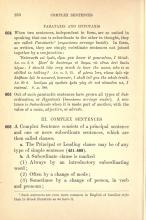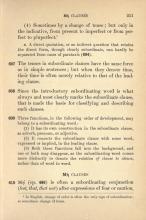606. A Complex Sentence consists of a principal sentence and one or more subordinate sentences, which are then called clauses.
a. The Principal or Leading clause may be of any type of simple sentence (§§ 451 – 489).
b. A Subordinate clause is marked
1. Always by an introductory subordinating word;
2. Often by a change of mode;
3. Sometimes by a change of person, in verb and pronoun;
4. Sometimes by a change of tense; but only in the indicative, from present to imperfect or from perfect to pluperfect.[fn]In English, change of order is often the only sign of subordination; so sometimes change of tense.[/fn]
c. A direct quotation, or an indirect question that retains the direct form, though clearly subordinate, can hardly be separated from cases of parataxis (§ 604).
607. The tenses in subordinate clauses have the same force as in simple sentences; but when they denote time, their time is often merely relative to that of the leading clause.
608. Since the introductory subordinating word is what always and most clearly marks the subordinate clause, that is made the basis for classifying and describing such clauses.
609. Three functions, in the following order of development, may belong to a subordinating word:
1. It has its own construction in the subordinate clause, as adverb, pronoun, or adjective.
2. It connects the subordinate clause with some word, expressed or implied, in the leading clause.
3. Both these functions fall into the background, and one or both may disappear, as the subordinating word comes more distinctly to denote the relation of clause to clause, rather than of word to word.


